Aquarium crabs: species, feeding and maintenance
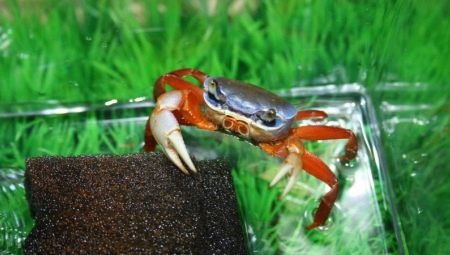
As soon as an aquarium appears in the house, it turns out that aquarium hobby is a whole world, interesting and exciting. At first, you just want a flock of beautiful fish that will gracefully swim between algae and shells for the amusement of households. And then there is more knowledge, and the owner realizes that he himself is creating a small ecosystem. At a certain moment, only fish are already few, I want to put a living creature in the aquarium more fun. For example, a crab.
It will be interesting for adults and children to watch him, he will become a real hero of the aquarium, a universal favorite and an object of care.
Peculiarities
Crabs have not yet passed into the category of habitual inhabitants of domestic living corners, they are quite rightly considered exotic. This circumstance also has a negative connotation: not every seller in a pet store can inform the buyer about how to care for a crab, what he needs for a normal existence, what to feed it... And the owner, unprepared for the appearance of such an underwater inhabitant in the house, cannot create normal conditions for him, which is why the crab dies, and the joy of acquiring turns into a real drama.
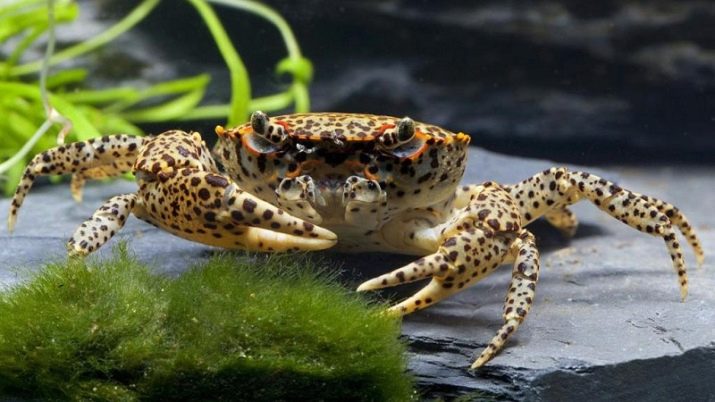
It cannot be said that it is very difficult to create conditions for crabs. But some preparation is needed. Aquarium crabs, if you take their establishment very seriously, should live in a special aquaterrarium. There are certain types of marine abodes that get along well in the aquarium, and they should be purchased. But only if you are confident that you can provide them with proper care, as they have a number of interesting features.
- Many of them have an extremely quarrelsome, grumpy character, and they are negatively disposed even towards their relatives. If you put 2 males in one aquarium, they will be in constant conflict. Crabs love to fight both for the territory and for the female. Duels are serious: they tear off each other's limbs, if the fight is not stopped.
- The best solution would be to populate 2 heterosexual crabs in a small area. If you want a whole colony, everyone has to get their own plot, and this requires a very large aquarium. For all types of crabs, 30% of the land is enough for a happy life, everything else is water.
- In an aquarium where arthropods will live, there must be a very powerful filtration system. Arthropods are still clean, they have the highest sensitivity to pollution. It's good if you can install an external filter.
- If you imagine the most picturesque underwater gardens, where crabs will slowly pace among the climbing emerald algae, the reality will not be so beautiful. Arthropods try to dig up and eat almost all plantings.
- An aquarium or aquaterrarium should have a cover: without it, you risk losing your many-legged pet. They really make daring escapes, then you have to look for them all over the apartment. Although there is a little secret here: if the crab has escaped, put a container of water in a prominent place, it will certainly come running there when it gets tired of the land.
- In captivity, crabs, alas, do not breed. Therefore, there is little hope that you will be able to see the offspring that has grown in front of your eyes.
- Crustaceans are able to live in fresh water, but many representatives of arthropods still prefer brackish water. Therefore, it will have to be slightly salted. If you don't, the crab won't live long.
- Crabs also moult, and this period is very delicate for them. They prefer to experience it in shelters, so you should think about their organization even before purchasing a crab.
There is nothing wrong with molting itself: crustaceans shed their already tight chitinous shell so that a new one appears.

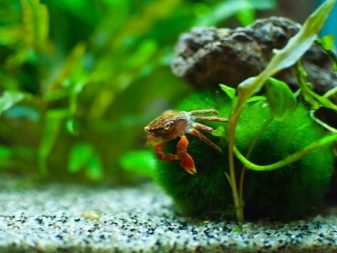
Advantages and disadvantages
Domestic crab is a very conventional term. Previously, crabs that could live in fresh water in an aquarium were practically not sold. Unless a mangrove could be offered in a pet store for exotic lovers. Today the list of possible inhabitants of this species has expanded. Almost all varieties of crabs need precise keeping conditions: mineralized hard water with added salt. The main disadvantages of arthropods in the aquarium:
- unfriendly;
- can escape if the aquarium is not covered;
- encroach on vegetation in the aquarium (dig up, eat).
The following factors are considered the advantages of crabs:
- live long - from 3 to 6 years;
- interesting as an object for observation;
- decorative qualities at the highest level.
It is worth noting that they are, in a sense, the orderlies of their ecosystem. Arthropods eat up food that has fallen to the bottom of the aquarium, preventing it from going out. Some may even clean pebbles of grass, as if polishing them.
It happens that crabs eat a gape of fish, but this behavior in the presence of constant feeding is still atypical.
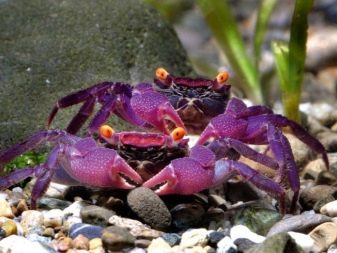
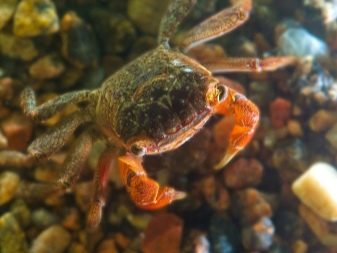
Views
There are several types of arthropods.
Crab dutch
The most common aquarium crab is perhaps the Dutch one. Its name is dictated by its habitat: it is found in the reservoirs of Holland, and also in the Caspian and Azov Seas. Features of the view:
- not very large in size, 3 cm wide;
- their shell is all mini-granules, the crab itself is dark in color;
- a fundamental difference between the sexes in the size of the shell and claws: males will be larger;
- the Dutch do not show much aggression towards fish;
- can live in a freshwater aquarium;
- actively feast on live plants;
- the main conditions of the living space are powerful aeration and a lot of shells, snags for crustacean shelters.
The Dutch crab is picky about food, it can eat simple fish food, live or dry. It is unlikely that he will refuse fresh raspberries or a small piece of beef.
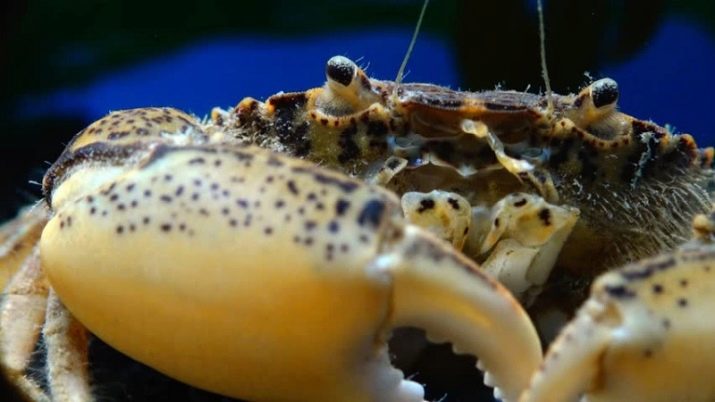
Red mangrove
Lives in nature in the waters of South Asia. Usually inhabits the sandy shore, under any threat it goes into the water. The pet itself is red, the claws are bluish. Females and males differ in abdomen: in males, the abdomen is fallen, in females it is dense. Mangroves live both singly and in pairs. Sometimes they are aggressive towards relatives. The tank should be at least 60 liters, and preferably 80 liters, in a smaller volume it will be cramped for crabs.
Ideal for mangrove crab (as for other species, however) aquaterrarium... In it, crabs will be able to go out on land, bask in artificial light. This system is close to natural, its conditions are more suitable for crustaceans.

Rainbow
Will compete in popularity with the Dutch rainbow crab. It is often called differently: indigo, terrestrial, tricolor, patriot. In nature, the rainbow crab is found on the Pacific shores. This species is distinguished by a special, very bright color. The carapace can be purple or bright blue, the limbs are dark orange, the lower part is light beige. An adult arthropod grows up to 20 cm.
The rainbow crab is considered a capricious inhabitant of the home "sea". They just need an aquaterrarium, and even a spacious one. He needs more land, water needs relatively little. In nature, for example, this species prefers to be in the water only at the stage of molting and reproduction, the rest of the time the crab is on the shore.
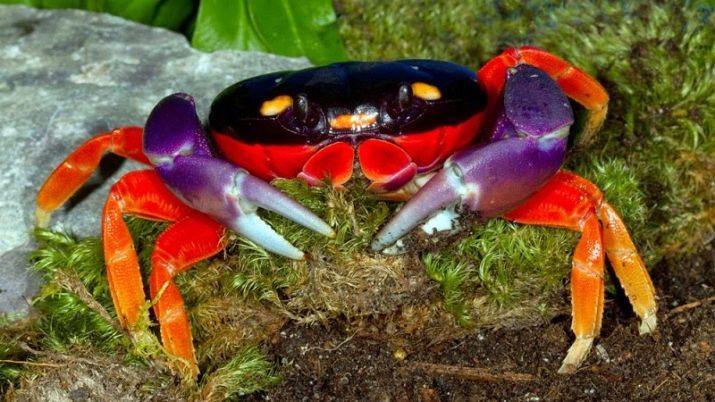
Malawian
Many representatives of this species live in Lake Malawi in East Africa. Hence the name. The crab is beautiful in color: its shell and limbs are blue, and the lower body is colored burgundy or brown. Despite its cute appearance, the crab is quite aggressive. One of his hobbies is to build slides from pebbles, and if the tank is not closed, an arthropod can climb up such a slide and run away.
Do not feed the Malawian crab with protein too much: it has been proven that protein food increases the aggressiveness of the pet.

Vampire
One of the most exotic crabs: its body is painted in a very expressive purple color. The eyes of the arthropod are also expressive: bright orange. It is small in size, up to 3 cm. Therefore, an aquarium or aquaterrarium of 30–40 liters is enough for such a representative of crustaceans. At home, he eats small insects or special food for crabs.
A pleasant difference from other species is friendliness. He gets along with neighbors, does not show aggression, does not divide territory. The vampire crab does not tolerate acclimatization. And also not all representatives of the species can safely tolerate molting. During this period, arthropods are vulnerable, their immunity is greatly weakened.
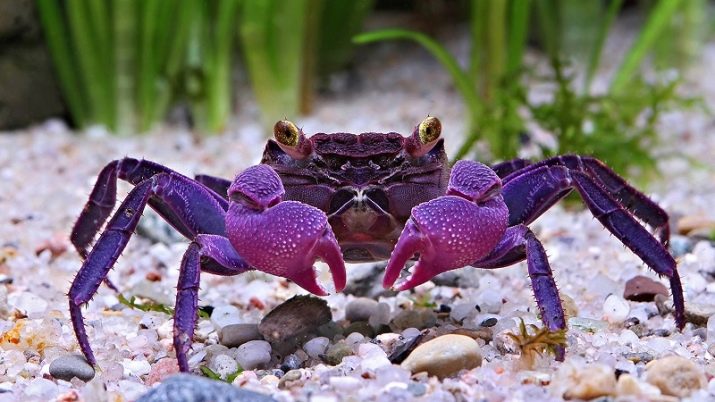
Red Devil
The specific color of the crab's body influenced its name. Someone will say that he looks frightening, someone will argue and call the red devil a real handsome man. The limbs, sides and muzzle of the crab are black, and the head, claws and spots on the shell are bright red.
But, despite the loud name, This crab is not aggressive, it gets along calmly with peaceful fish... It is also easier for him to live in an aquaterrarium equipped with a small water part, everything else is taken under land. Plants can be planted on land.

Royal leopard
Sometimes this species is called panther, although the word "leopard" suits it better. These crabs are found in freshwater waters in Indonesia. The color of the crab really resembles the skin of a leopard, all over the body (except for the bottom) it is covered with dark spots. Such a crab can grow up to 12 cm.
The nature of the arthropod is aggressive, it will defend its territory to the last, not letting any relatives or strangers on him. The fact that the leopard crab actually does not need dry land pleases lovers of such exoticism.
In the aquarium, you need to plant some plants that will be edible for crustaceans.

Dwarf
It is the smallest of the invertebrates. An adult grows up to a maximum of 1.3 cm. Such a small size gave it an alternative name - a spider crab or a microspider. Dwarf arthropods do not differ in bright color. Their bodies are gray or faded green. On the body there are small fluffs that help the crab to filter the water, as well as look for food at the bottom.
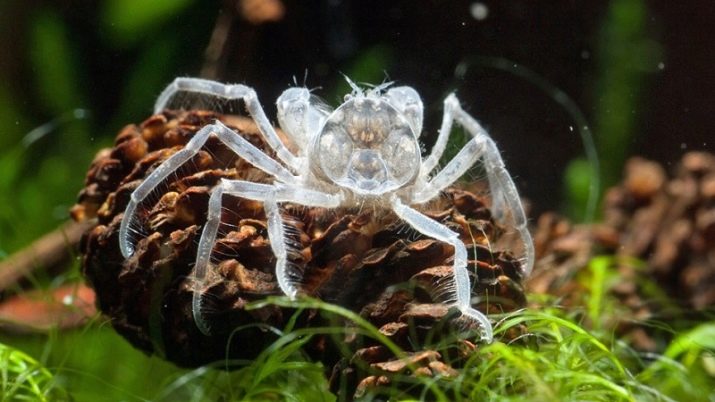
How to choose?
Crabs are close relatives of crayfish, only they do not have an abdomen (more precisely, they do, but very small). They also do not have a tail, because it would prevent crabs from moving on land. To choose a crab, evaluate:
- its size - a large pet needs a large aquarium;
- character - if the crab is not the only inhabitant of the aquarium, try to acquire non-aggressive species of arthropods;
- the amount of information on caring for it - if it is a rare crab, there may be little information, with common species this will not be a problem.
Many lovers of exotic pets try to take a couple: a male and a female, hoping that they will live in harmony and provide replenishment. But under unnatural conditions, crustaceans do not acquire offspring.
Be sure to study compatibility with other inhabitants of the aquarium (and specifically those that you already have) before choosing a crab.
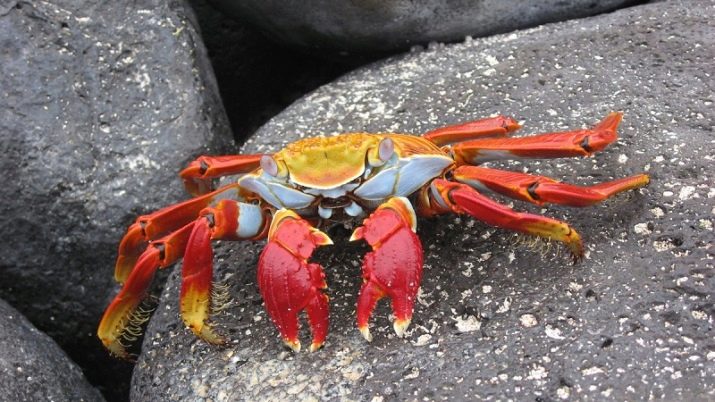
Features of the content in the aquarium
On average, the aquarium for a comfortable stay of crabs should be with a filling capacity of 50 liters. More is possible, less is rare, for small species. The height of water in such containers should be at least 10–15 cm. Almost all crustaceans need clean water without nitrate impurities, ammonia, and heavy metal salts. It is important to maintain a slow flow in the aquarium. Attention! Indicators of water - 24-26 °, on the dry part - 25-28 °.
Tropical crabs that live in freshwater are considered active, mobile creatures. They like it when there are several labyrinths, shelters in the aquarium. A vampire, for example, loves sphagnum at the bottom of his house. Decorations each type of crab prefers its own: some like sand, others - only the bottom with silt. Vampire and red claw crabs can live comfortably in a thin layer of sand. The tank should contain driftwood and stones, plants with hard leaves, since crabs are used to getting their food there.
Zeolite mixed with coral chips can be considered a universal soil for crab. Mixtures with tuff granules and granite gravel are also used. Just do not take very small granules, their size should be 3-5 mm. From time to time, the soil should be siphoned; it is almost impossible to do this with small granules: the stream will simply carry away the light elements.
Long before you add arthropods to the aquarium (at least 10 days), plant nitrifying bacteria in the tank. And you can also let small fish there, which tolerate an alkaline environment well. Filters and heating pads in the crabs' dwelling are unnecessary, they will be an extra hazard in the tank (wires). Stories when arthropods died from a short circuit in an aquarium are not isolated. The crabs see the wire, cut it with their pincers and it all ends tragically.


The crab's lifestyle can be called burrowing-digging, they like to make holes in the ground. But by doing so, crabs can deform the coast. To avoid trouble, a pipe should be placed at an angle on the bank, in section slightly exceeding the diameter of the shell. True, the state of the pipe must be monitored: stagnation of water is unacceptable in it, there must always be enough air in it. That is, the pipe needs to be ventilated.
Important! Before you start a crab, take care of purchasing an aquaterrarium.
Many do not think to get such a device, considering that the crab will live normally in a standard aquarium. But for the lungs, which include the crab, it is important to mimic the natural ecosystem.
Only a few species of crabs are able to do without sushi. Without a shore, arthropods can die, many species of crabs are out of water from 60 to 90% of the time. There can be no flat land, a small rise is required, along which the crab will easily climb up. Skilled owners make their own aquaterrariums based on an ordinary mini-aquarium. Seasonally, the crab moults, its frequency depends mainly on the literacy of caring for the pet. Molting is carried out in salt water. This is a significant stage for the growth of the crustacean. For several hours he sits in the water and smoothly, slowly, from the crumbling chitinous shell, takes out all the limbs and body. Then the weakened crab must lie down: for this it settles down in a suitable shelter. And the crab will come out "into the light" only when it gets stronger.
At the stage of molting, arthropods are vulnerable, they often become prey for neighbors in the aquarium, therefore protection from fellow crab is needed. Occasionally, crustaceans die during molting. If you do not violate the rules of care, competently equip the crab's home, feed it well, the pet will live up to 5 years.
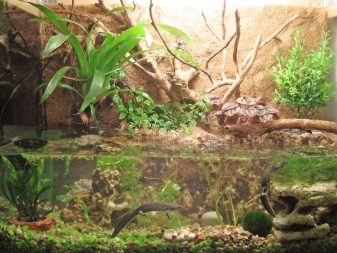
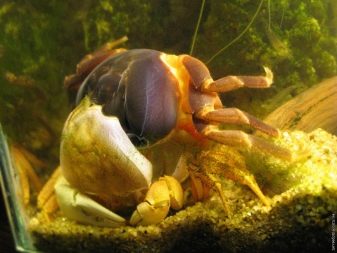
What to feed?
Almost all crabs will be happy to feast on fish food. They will love dried gammarus, mealworms and bloodworms, and daphnia. Gifts for arthropods can be considered:
- shellfish: mussels and squid;
- snails;
- crickets;
- white fish meat;
- lean meat.
If you want your pet to grow up healthy, you will have to prepare a kind of omelet for him, consisting of dried nettle, paprika and fine calcium salt. Crabs are able to destroy algae growing for decorative purposes in the pool. To prevent hungry arthropods from eating all this beauty, they need to be fed with oranges, apples, bell peppers, spinach, nettles, pumpkin. They will not give up on Brussels sprouts, dandelion leaves, boiled carrots.
The food should be laid out in a dry place. Food should not be in the water, since, decomposing, it will be toxic to water. This is fraught with disease outbreaks in the crab. A typical mistake many owners make is to feed an arthropod. One third of the crab's body will be a rough guide to the amount of feed required.
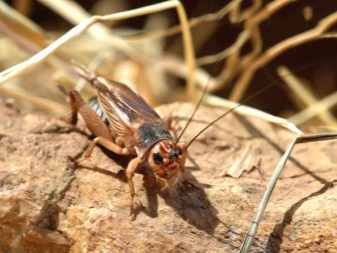

Breeding
If you have crabs for posterity, nothing will come of this idea. In nature, crabs breed all summer long, warm and comfortable weather is important for them. Reproduction is carried out by laying eggs. But all this happens in the ocean: the offspring cannot ignore the plankton stage. And while mating behavior of crabs may well be present, captive breeding is virtually impossible.
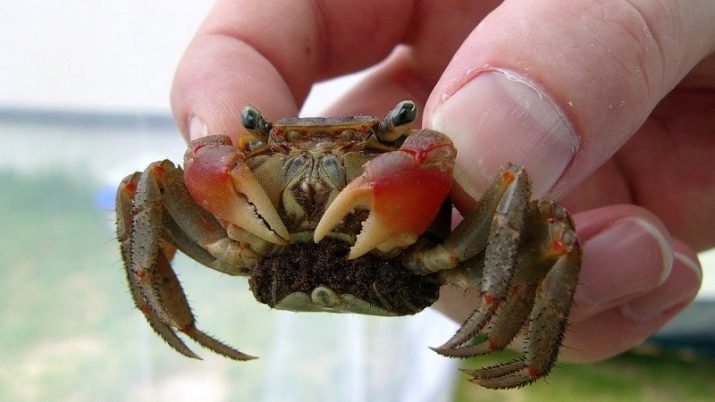
Fish Compatibility
Often, buyers ask the seller at the pet store if the crab will be bored in the aquarium if they buy it alone, without a pair. Crabs are calm about loneliness, many species cannot stand the neighborhood even with representatives of their own species. They are characterized by the so-called territorial behavior. The crab will fight fiercely with rivals, losing its claws (which, by the way, will grow).
Crabs tend to hurt other neighbors too, and in the literal sense of the word. If leisurely fish swim in the aquarium, it will be difficult for them to resist the frequent attack of crabs, and the latter strive to pinch the fish. Relatively good compatibility was found in crabs with some of their species:
- zebrafish;
- barbs;
- molliesia;
- guppy;
- swordsmen.
And also crabs can live in the same ecosystem with macrobrachium shrimp. You should not buy pets in the aquarium at random: find out everything about the inhabitant of the aquarium, from dietary habits to compatibility with other marine inhabitants.
Make sure you are ready to set up a cozy place for your pet so that it does not show up in the house just for everyone's fun.


For information on how to keep and what to feed the rainbow crab, see the next video.








